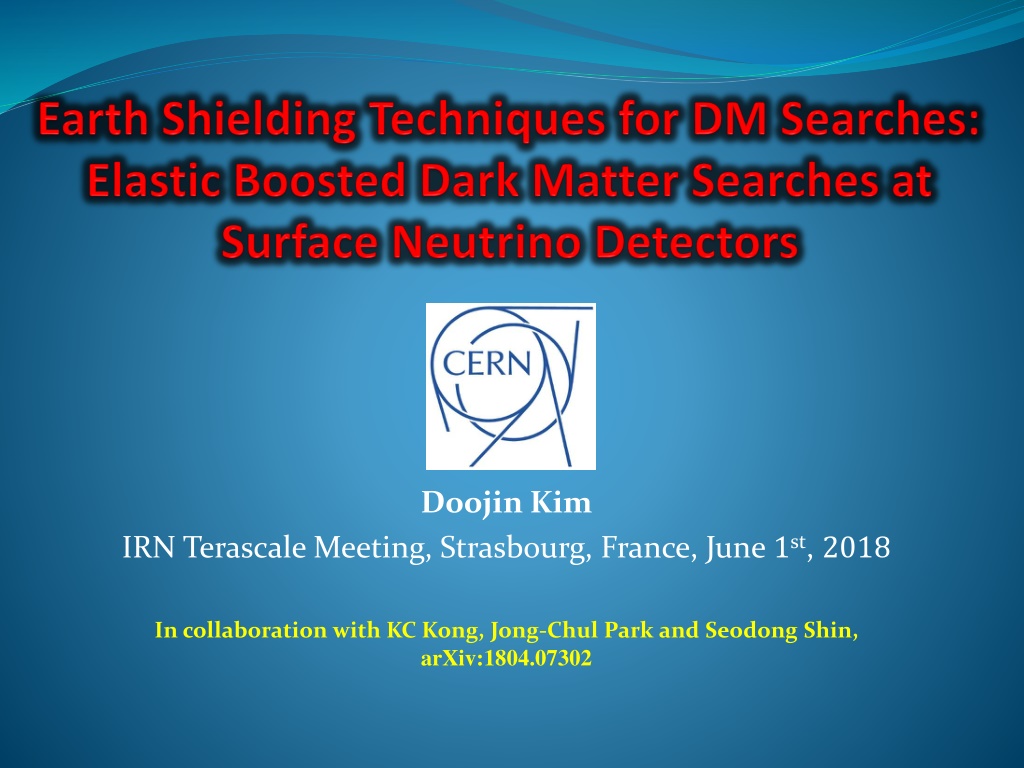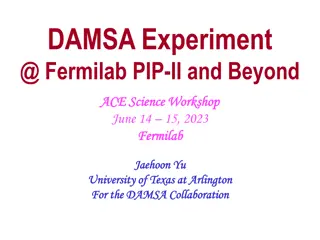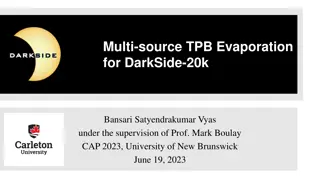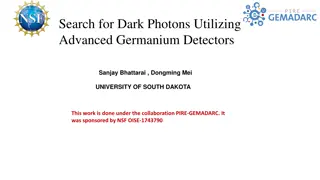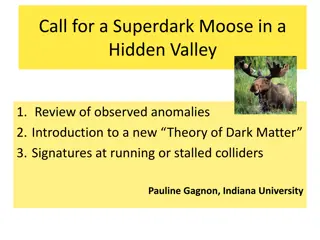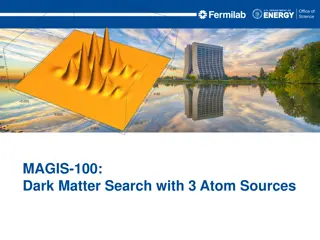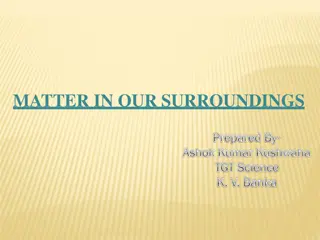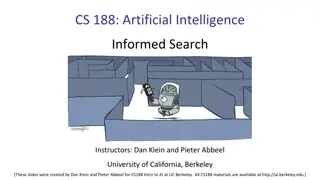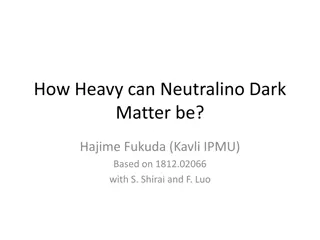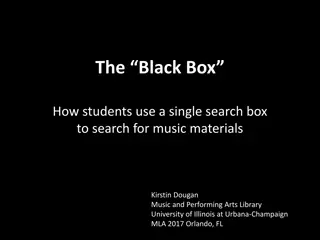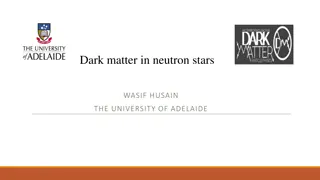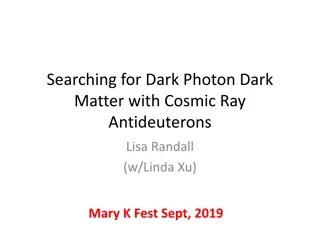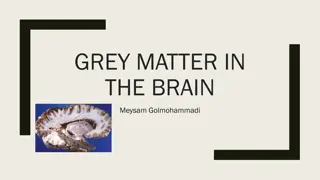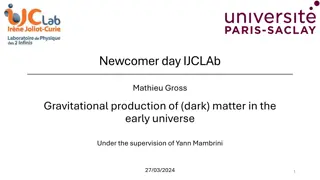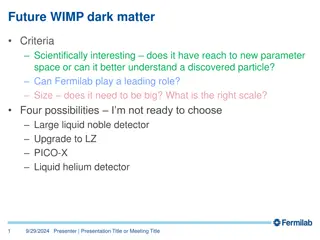Dark Matter Search at Terascale Meeting in Strasbourg
Doojin Kim presents research on non-relativistic dark matter search, focusing on weakly interacting massive particles (WIMPs) and generic boosted dark matter (BDM) signatures at the Terascale Meeting in Strasbourg. The study explores various scenarios and production models for detecting elusive dark matter particles, emphasizing the need for new ideas in this challenging field. Kim discusses challenges such as cosmic-origin backgrounds and signals of interest, like cosmogenic neutrons and atmospheric neutrinos, highlighting the importance of minimizing error rates in data analysis for accurate results.
Download Presentation

Please find below an Image/Link to download the presentation.
The content on the website is provided AS IS for your information and personal use only. It may not be sold, licensed, or shared on other websites without obtaining consent from the author.If you encounter any issues during the download, it is possible that the publisher has removed the file from their server.
You are allowed to download the files provided on this website for personal or commercial use, subject to the condition that they are used lawfully. All files are the property of their respective owners.
The content on the website is provided AS IS for your information and personal use only. It may not be sold, licensed, or shared on other websites without obtaining consent from the author.
E N D
Presentation Transcript
Doojin Kim IRN Terascale Meeting, Strasbourg, France, June 1st, 2018 In collaboration with KC Kong, Jong-Chul Park and Seodong Shin, arXiv:1804.07302
Non-relativistic Dark Matter Search (Mostly) focusing on weakly interacting massive particles (WIMPs) search [Cushman, Calbiati, McKinsey, (2013); Baudis (2014)] ? ? N ?recoil~1 100 keV Detectors Non-relativistic, designed to be elastic scattering other other sensitive to this Null observation of WIMP signals of weak-scale DM energy scale A wide range of parameter space already excluded with nuclei o or electron r electron Close to the neutrino floor Need new ideas! -1- Doojin Kim, CERN IRN Terascale Meeting at Strasbourg
Generic Boosted DM (BDM) Signatures (?) Elastic scattering (eBDM) (cf. eBDM at underground detectors [Agashe et al. (2014); Berger et al. (2014); Kong et al. (2014); Alhazmi et al. (2016); Cherry et al. (2017); many more]) Detector ?1 ?1 ?1 ?0= ?1= ~30 MeV ~10 GeV with ?1= ~10 1 10 6 cm 2s 1 ? Today s focus (in collaboration with Kong, Park and Shin, arXiv:1804.07302) ?/? ?/? ?1 ?0 (?) Inelastic scattering (iBDM) (cf. iBDM at underground detectors [DK, Park, Shin (2016); Giudice, DK, Park, Shin (2017)]) ?1 ?0 Detector ?1 ?1 ?2 ?1 Galactic Center ? ?/? ?/? ?0: heavier DM ?1: lighter DM ?1: boost factor of ?1 ?2: massive unstable dark-sector state ?: mediator/portal particle (in)visible Study at ProtoDUNE [arXiv:1803.03264 in collaboration with Chatterjee et al.] -2- Doojin Kim, CERN IRN Terascale Meeting at Strasbourg
Production of BDM & Benchmark Model Production of boosted DM: two-component boosted DM scenario [Agashe, Cui, Necib, Thaler (2014)] int ? 2??????+ ?11 ?1???1??+ ?12 ?2???1??+ h.c.+(others) Vector portal (e.g., dark gauge boson scenario) [Holdom (1986)] ? ? Dark SM Fermionic DM ? ?2: a heavier (unstable) dark-sector state Flavor-conserving neutral current elastic scattering ?2 ? ?12 Flavor-changing neutral current inelastic scattering Not restricted to this model: various models conceiving BDM signatures ?1 BDM source: galactic center, solar capture, dwarf galaxies, assisted freeze-out, semi-annihilation, fast- moving DM etc. [Agashe et al. (2014); Berger et al. (2014); Kong et al. (2014); Alhazmi et al. (2016); Super-K (2017); Belanger et al. (2011); D Eramo et al. (2010); Huang et al. (2013)] Portal: vector portal, scalar portal, etc. DM spin: fermionic DM, scalar DM, etc. iBDM-inducing operator: two chiral fermions, two real scalars, dipole moment interactions, etc. [Tucker- Smith, Weiner (2001); Giudice, DK, Park, Shin (2017)] -3- Doojin Kim, CERN IRN Terascale Meeting at Strasbourg
Challenge: Cosmic-origin BGs and eBDM Signal Signal of interest Cosmogenic neutrons (very rare) Quite a few low-energy particles ? Vertical muons above 10 MeV: ~1010 /m2/yr [PDG (2016)] Atmospheric neutrinos (very rare): ~40 single-track- involving e-like events/yr/kt [Super- K (2015;2017); DUNE (2015)] ? ? An impractically small mistake rate is demanded! Fiducial vol. Total vol. Active vol. Outer structure irreducible -4- Doojin Kim, CERN IRN Terascale Meeting at Strasbourg
Earth Shielding Accept only events Cosmic muons Boosted DM traveling through the earth (i.e., coming out of Background and signal the bottom surface) at the events are coming from price of half statistics; everywhere. direction inferred from Half of them travel recoil track Essentially no through the earth. cosmic-origin BGs except Earth atmospheric neutrino Backgrounds can t background (cf. observation penetrate the earth while of upward-muons induced by signals can! muon neutrinos created by DM annihilation [NOvA Collaboration, in progress]) -5- Doojin Kim, CERN IRN Terascale Meeting at Strasbourg
Muon Flux inside the Earth ?? at sea level is ~100 m 2s 1sr 1= 3 109 m 2yr 1sr 1. [Particle Data Group (2015)] ?? at 20 km.w.e. 7 km below sea level is ~10 9 m 2s 1sr 1, i.e., suppressed by a factor of ~1011. (Potential) muon- induced BG is negligible for muons incident at ? > ???. ??? ??? 7 km 0.03 2? ? 2??? [Particle Data Group (2015)] Flattened by neutrino-genic muons -6- Doojin Kim, CERN IRN Terascale Meeting at Strasbourg
Situation with 1-yr Data Collection from All Sky ?? ? ~40 single-track events/yr/kt ?1~3 (101 106) 2 neutrino-induced e-like, cm 2yr 1 2 Effectively, half year -7- Doojin Kim, CERN IRN Terascale Meeting at Strasbourg
Benchmark Detectors MicroBooNE: ongoing since July 2015 ProtoDUNE: beginning operation in September 2018 and now planned to take cosmic data for new physics searches -8- Doojin Kim, CERN IRN Terascale Meeting at Strasbourg
Model-independent Sensitivity Number of signal events ?sig is ?sig= ?? ?exp ?? ??: scattering cross section between ?1 and (target) electron : flux of incoming (boosted) ?1 ?exp: exposure time Controllable! (once a detector is determined) ??: total # of target electrons Realistic experimental effects such as cuts, energy threshold, etc are absorbed into ??. -9- Doojin Kim, CERN IRN Terascale Meeting at Strasbourg
More Familiar Form More familiar parameterization possible with the below modification! 90% C.L. ?? ?? vs. ?0(just like ? vs. ?DM in conventional WIMP searches) -10- Doojin Kim, CERN IRN Terascale Meeting at Strasbourg
Model-independent Sensitivity 1-year exposure, i.e., effectively half-year data collection (= 1.6 107 sec), is assumed. The limits from all-sky data are DM halo model- independent (up to total flux), and obtained without any particular assumption on the model to describe the interaction between SM particles and the boosted dark matter. -11- Doojin Kim, CERN IRN Terascale Meeting at Strasbourg
Dark Photon Parameter Space: Invisible X Decay Case study 1: mass spectra for which dark photon decays Babar into DM pairs, i.e., ??> 2?1 1-year data collection from the entire sky and ?11= 1 are assumed. A wide range of unexplored parameter space can be probed at surface-based detectors. -12- Doojin Kim, CERN IRN Terascale Meeting at Strasbourg
Dark Photon Parameter Space: Visible X decay Case study 2: mass spectra for which dark photon decays NA48/2 Babar into lepton pairs, i.e., ??< 2?1 1-year data collection from the entire sky and ?11= 1 are assumed. A wide range of unexplored parameter space can be probed at surface-based detectors. -13- Doojin Kim, CERN IRN Terascale Meeting at Strasbourg
Expected Number of Signal Events A 0.5 kt-?fid detector and 2?1> ?? (i.e., the case of visibly-decaying X) and ?11= 1 are assumed. Shown are the results with 1-year (effectively -year) exposure. SK 30 cone 90% C.L. from a BDM search SK all-sky 90% C.L. from SK all-sky 90% C.L. from atm-? measurements atm-? measurements Full ProtoDUNE/SBN can cover the parameter space uncovered by SK! (especially the region where the relevant recoil energy is lower than 100 MeV.) -14- Doojin Kim, CERN IRN Terascale Meeting at Strasbourg
Expected Experimental Reach A 0.5 kt-?fid detector and 2?1> ?? (i.e., the case of visibly-decaying X) and ?11= 1 are assumed. Shown are the results with 1-year and 2-year exposures. SK 30 cone 90% C.L. from a BDM search SK all-sky 90% C.L. from SK all-sky 90% C.L. from atm-? measurements atm-? measurements The analysis with an angle cut allows to probe more parameter space, as expected. -15- Doojin Kim, CERN IRN Terascale Meeting at Strasbourg
Conclusions ??? Non-relativistic (??? ?) Relativistic (???~?) Scattering elastic Direct detection Boosted DM (eBDM) inelastic BDM (?BDM) inelastic inelastic DM (iDM) Overwhelming cosmic-ray background can be controlledwith the Earth Shielding . Surface-based neutrino detectors possess excellent sensitivities to a wide range of boosted DM, hence allows a deeper understanding in non-minimal dark sector physics. Surface-based neutrino detectors can provide an alternative avenue to probe dark photon parameter space. -16- Doojin Kim, CERN IRN Terascale Meeting at Strasbourg
Two-component Boosted DM Scenario A possible relativistic source: BDM scenario (cosmic frontier), stability of the two DM species ensured by separate symmetries, e.g., ?2 ?2 , ? 1 ? 1 ,etc. ?0 ?1 SM Dominant relic ?0 ?1 SM Freeze-out first Freeze-out later Negligible, non-relativistic relic ?1 ?1 ?0 Assisted freeze-out mechanism [Belanger, Park (2011)] -18- Doojin Kim, CERN IRN Terascale Meeting at Strasbourg
Relativistic Dark Matter Search ?0 ?1 SM ?0 ?1 SM Heavier relic ?0: hard to detect it due to tiny/negligible coupling to SM Lighter relic ?1: hard to detect it due to small amount ?0 ?1 ?1 becomes boosted, hence relativistic! (?1= ?0/?1) ?0 ?1 (Galactic Center at CURRENT universe) (Laboratory) [Agashe, Cui, Necib, Thaler (2014)] -19- Doojin Kim, CERN IRN Terascale Meeting at Strasbourg
eBDM Search at Super-K [Super-K Collaboration, (2017)] High threshold energy Single-ring-like objects only -20- Doojin Kim, CERN IRN Terascale Meeting at Strasbourg
Improving Signal Sensitivities The neutrino flux is uniformly distributed, whereas the boosted DM flux is mostly coming from the Galactic Center! An angle cut improves! [Necib, Moon, Wongjirad, Conrad (2016); Super-K (2017)] ?? What value of ?? is the best/most optimal choice? -21- Doojin Kim, CERN IRN Terascale Meeting at Strasbourg
Angular Cut to Maximize the Signal Sensitivity Various significance calculation methods are considered since # of expected BG events are small. Comparison of different signal events for a Comparison of different exposure times for fixed number of BG events a fixed model point A larger angle cut is better if # of signal is A larger angle cut is better if more data is bigger. collected. -22- Doojin Kim, CERN IRN Terascale Meeting at Strasbourg
Model-independent Sensitivity with Angle Cut -23- Doojin Kim, CERN IRN Terascale Meeting at Strasbourg
